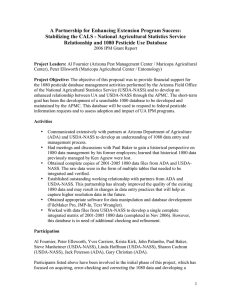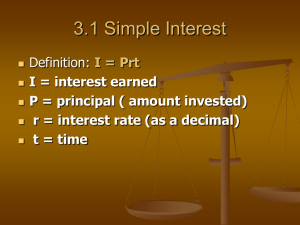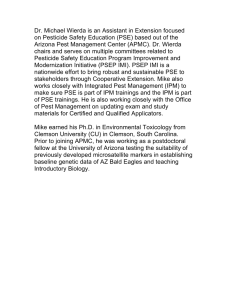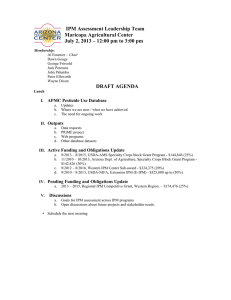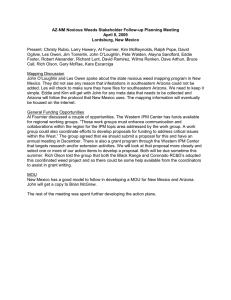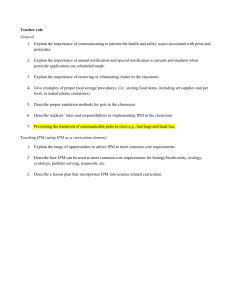The 1080 Pesticide Use Reporting Database: Improvement
advertisement
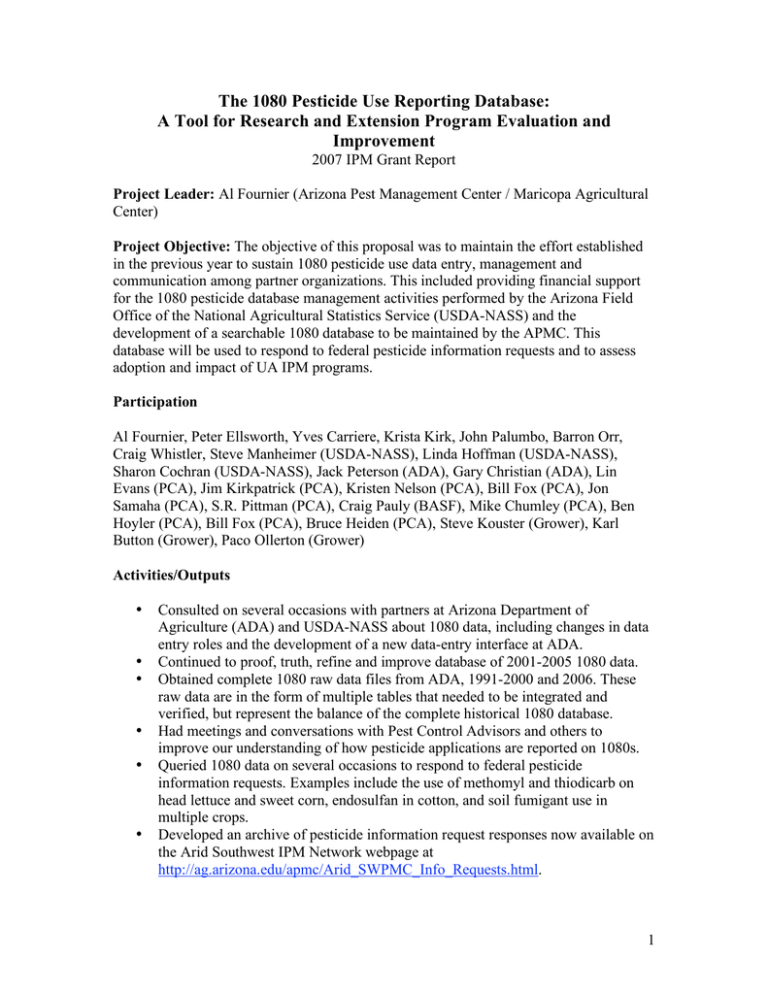
The 1080 Pesticide Use Reporting Database: A Tool for Research and Extension Program Evaluation and Improvement 2007 IPM Grant Report Project Leader: Al Fournier (Arizona Pest Management Center / Maricopa Agricultural Center) Project Objective: The objective of this proposal was to maintain the effort established in the previous year to sustain 1080 pesticide use data entry, management and communication among partner organizations. This included providing financial support for the 1080 pesticide database management activities performed by the Arizona Field Office of the National Agricultural Statistics Service (USDA-NASS) and the development of a searchable 1080 database to be maintained by the APMC. This database will be used to respond to federal pesticide information requests and to assess adoption and impact of UA IPM programs. Participation Al Fournier, Peter Ellsworth, Yves Carriere, Krista Kirk, John Palumbo, Barron Orr, Craig Whistler, Steve Manheimer (USDA-NASS), Linda Hoffman (USDA-NASS), Sharon Cochran (USDA-NASS), Jack Peterson (ADA), Gary Christian (ADA), Lin Evans (PCA), Jim Kirkpatrick (PCA), Kristen Nelson (PCA), Bill Fox (PCA), Jon Samaha (PCA), S.R. Pittman (PCA), Craig Pauly (BASF), Mike Chumley (PCA), Ben Hoyler (PCA), Bill Fox (PCA), Bruce Heiden (PCA), Steve Kouster (Grower), Karl Button (Grower), Paco Ollerton (Grower) Activities/Outputs • • • • • • Consulted on several occasions with partners at Arizona Department of Agriculture (ADA) and USDA-NASS about 1080 data, including changes in data entry roles and the development of a new data-entry interface at ADA. Continued to proof, truth, refine and improve database of 2001-2005 1080 data. Obtained complete 1080 raw data files from ADA, 1991-2000 and 2006. These raw data are in the form of multiple tables that needed to be integrated and verified, but represent the balance of the complete historical 1080 database. Had meetings and conversations with Pest Control Advisors and others to improve our understanding of how pesticide applications are reported on 1080s. Queried 1080 data on several occasions to respond to federal pesticide information requests. Examples include the use of methomyl and thiodicarb on head lettuce and sweet corn, endosulfan in cotton, and soil fumigant use in multiple crops. Developed an archive of pesticide information request responses now available on the Arid Southwest IPM Network webpage at http://ag.arizona.edu/apmc/Arid_SWPMC_Info_Requests.html. 1 • • Conducted an analysis of the economic impact of Lygus in Arizona cotton and published a UA Cotton Report article (http://cals.arizona.edu/pubs/crops/az1437/az14374a.pdf) and poster based on the results. Co-authors are A. Fournier, P.C. Ellsworth and V.M. Barkley. The poster was presented at the Second International Lygus Symposium in Pacific Grove, CA (4/07) and at the Entomological Society of America 2007 Annual Meeting in San Diego, CA (12/07). Peter Ellsworth and John Palumbo conducted preliminary analyses of adoption of cross-commodity guidelines for neonicotinoid use for whitefly control. Presentations of these analyses are available on the ACIS presentations page at http://ag.arizona.edu/crops/presentations/presentations.html. Outcomes / Current Status Short Term Outcomes: Improving the Data and Partner Relationships • • • Five years of 1080 data (2001-2005) have now been developed into a workable integrated database available for pesticide information queries. These data have been significantly corrected and improved from the source data. Over the past year, we have continued to improve and refine this database. A major short-term goal of this project, the development of stable cooperative relationships among the relevant partner organizations of ADA and AZ-NASS has been achieved. Our experience in working with and improving the 1080 data have provided with insights into data entry and management that are now informing the development of new data entry procedures at ADA. The quality of the current and future 1080 data has been significantly improved directly through the interactions between the APMC, USDA-NASS, ADA partners and others. The process of working with the raw data files from ADA and USDA-NASS has been documented and refined through successive iterations of data management. The experience we have gained will make future expansion and additions to the existing data more expeditious. Now that we have the complete historical database, we can begin this work to expand the data. Medium Term Outcomes: Federal Information Requests and Program Measurement • • The quality and accuracy of APMC responses to federal pesticide information requests have been greatly improved. The archive we have developed on the Arid Southwest IPM Network website (http://ag.arizona.edu/apmc/Arid_SWPMC_Info_Requests.html) improves our transparency and makes these reports available to all interested stakeholders. For examples of the use of 1080 data in pesticide use information responses see the reports for endosulfan, methomyl and thiodicarb or soil fumigants. The analysis of the economic impact of Lygus in Arizona cotton (developed using the 1080 database along with Cotton Insect Losses data) provides us with important baseline information on current Lygus management practices in cotton and their economic consequences. These data will be useful for measure 2 • anticipated changes in Lygus management that may follow the introduction of new management tools and new Extension resources expected to emerge from current Lygus research funded through a USDA-Risk Avoidance and Mitigation project. (http://cals.arizona.edu/pubs/crops/az1437/az14374a.pdf) The database has been used to conduct preliminary data analysis on the adoption of UA Extension guidelines for neonicotinoid use in cotton and vegetable crops. John Palumbo presented data at the 2006 Annual Meeting of the Entomological Society of America (ESA) and Peter Ellsworth presented data at the 4th International Bemisia Conference (12/06). This year, we have done considerable work with the 1080 database to facilitate the final spatial analyses of guidelines adoption. This work involving Al Fournier, Peter Ellsworth, John Palumbo and Yves Carriere is funded through a Western Regional IPM Competitive Grant. This project will be completed in 2008. Changing Partner Roles • In 2005-2006, USDA-NASS was responsible for all 1080 data entry while ADA personnel focused on error checking. In 2007, ADA personnel began entering raw 1080 data (2006 records) in parallel with USDA-NASS. This pilot effort was used to train ADA staff and to foster the development of a new user interface for data entry that includes error-checking. Beginning with the 2007 records, ADA will take over responsibility for all data entry. We will provide input to ADA that we hope will improve data entry procedures and 1080 data quality. We will continue to consult with personnel at USDA-NASS, whose long experience and historical knowledge of the 1080 data will be invaluable. Leveraged Resources • • The full budget from the 2006 APMC IPM grant ($8000) was used to partially support a Senior Office Specialist at USDA-NASS, to provide 1080 data entry, analysis, survey work and related functions. Leveraged funds to support USDANASS 1080 data work came from various Federal sources. Some of these federal resources would not have been provided without the support of the APMC grant funds. All APMC activities related to the project have been made possible through various leveraged resources, including: • A 2005 Western Regional IPM Competitive grant related to IPM program assessment provided significant salary support to Al Fournier and to Yves Carriere’s research technician Christa Kirk related to their1080 work. It is important to note that these funds have now been expended. • A separate APMC IPM grant for $3000 provided partial support for parttime IT personnel responsible for development of the Arid Southwest IPM Network website and maintenance of the APMC and ACIS websites, the posting of Pesticide Use Request reports, presentations, etc. • Partial salary support for Al Fournier was provided through a Western IPM Center Information Network grant that supported responses to federal 3 • • pesticide use requests and development of the Arid Southwest IPM Network website. The Arizona Department of Agriculture has contributed significant man-hours to 1080 data entry and to development of an improved data entry user interface. UA faculty members, ADA personnel, and USDA-NASS staff have contributed significant time and energy to this new partnership and continue to make themselves available as questions and concerns arise Continuing Need • • Much work remains to be done on the 1080 database. In particular, it will take a very significant investment of personnel resources to convert the balance of 11 years of historical 1080 data (1991-2000, 2006) into an integrated, proofed and useful database. The completion of this effort would yield a valuable historical data matrix that could provide insights on changes in pesticide use and Extension program adoption over time. We now have the experience to accomplish this task, provided sufficient personnel resources can be acquired and sustained. A major goal of the APMC is to secure funding to support an ongoing Information Technology position. This person would be responsible for continued development, expansion and maintenance of the 1080 database and maintenance and expansion of our three websites: The Arizona Crop Information Site (ACIS), the Arizona Pest Management Center website, and the Arid Southwest IPM Network website, and would work closely with the IPM Program Manager to achieve all IT goals. We have accomplished a great deal employing part-time help on a project-by-project basis. We believe that this additional investment of resources to support a full-time IT positions for the APMC would yield exponential benefits to our faculty and partner organizations. 4
